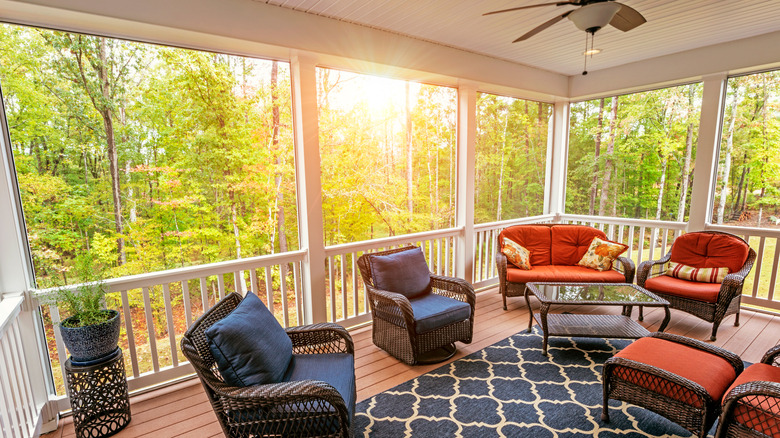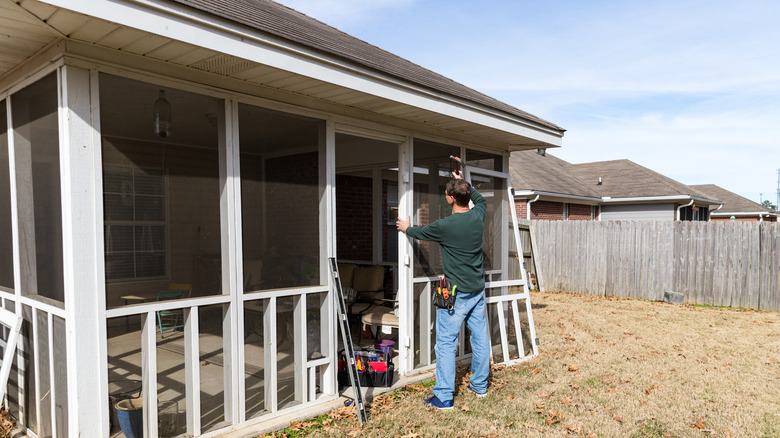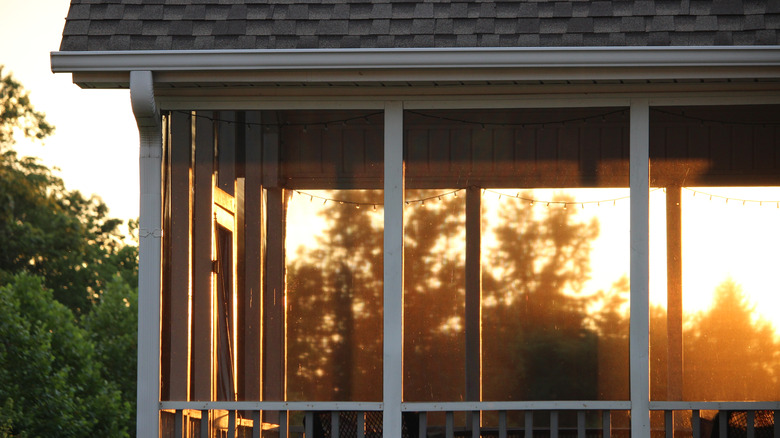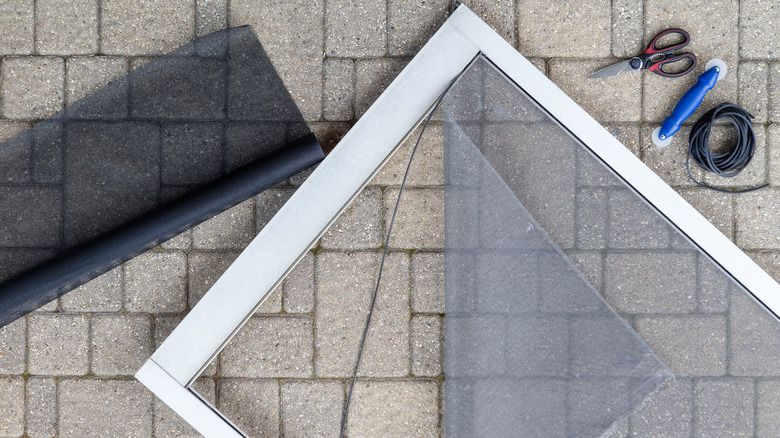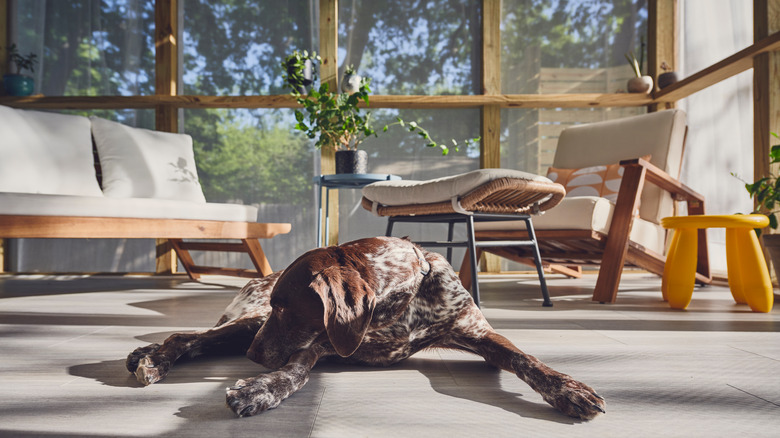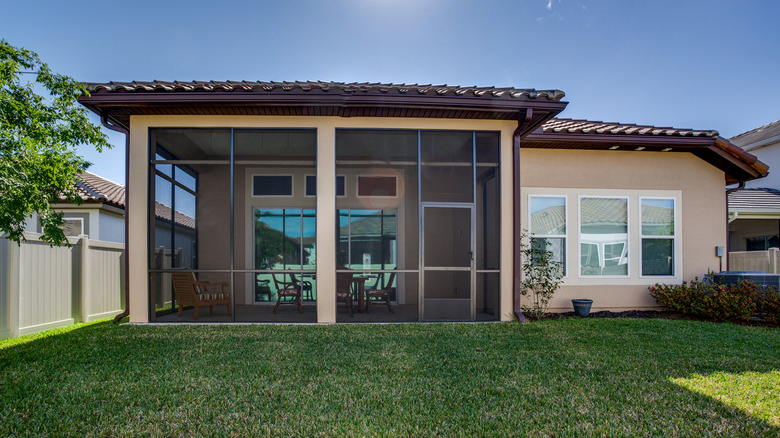How Much Does It Cost To Build A Screened-In Porch?
If you live where bugs like to make a meal out of anyone who ventures outside the protection of their home, you've probably considered screening in your porch so that you can fully enjoy your time spent outside. However, building a screened-in porch can be quite a hefty investment depending on your circumstances. According to HomeAdvisor, the average cost to build a 200-square-foot screened-in porch is about $2,400 under ideal conditions. This accounts for both labor (about $2 per square foot) and materials ($3-$5 per square foot).
According to HomeLight, building an enclosed porch will be much more expensive if you are starting from scratch as opposed to adding screening to an existing structure. Of course, using pricey materials and integrating modern features will also substantially increase the final price you pay when the project is completed. Whether you are considering building a screened-in porch from scratch or adding screening to an existing porch, read on for a detailed deep-dive on how much your project may end up costing you.
Factors for cost
In order to estimate the cost of a screened-in porch for your home, it's important to understand the key factors that will have the biggest impact on your total investment. From how your screened-in porch is built to the materials you'll use, there are plenty of details to consider.
Scope of Project
As noted above, there is a world of difference between funding the installation of a screen and door for a covered porch and building a screened-in porch entirely from scratch. According to HomeAdvisor, adding roofing to an existing porch usually costs between $3,200 and $6,000, whereas adding a screen to keep the bugs out will likely run you around $2,400. As such, the more "complete" your porch is in its current state, the less you will have to pay when it's time to add screening. Per U.S. News, building a screened-in porch can cost $65,000 or more when a house either doesn't have a porch, or the existing porch is riddled with issues.
Size of Porch
Per Home Advisor, the size of your porch will be one of the most important factors that determine the overall cost. This pertains to both labor (roughly $2 per square foot) and materials (about $4 per square foot), so those with a massive home and equally prodigious porch can end up spending over two or three times the amount of someone seeking a more modest-sized addition.
Materials Used
The materials you choose when constructing your enclosed porch can also have a massive effect on how much you pay in the end, as HomeLight explains. In terms of screens, you'll find the most value using aluminum mesh (roughly $3 per square foot) versus fiberglass ($4.50 per square foot). On the other hand, you can opt for a retractable screen, but these can cost $30 or more per square foot, which is significantly pricier. You'll also need to consider the cost of roofing materials, beams, and flooring if any of those elements need to be added or replaced to complete your porch.
DIY vs. Professional Installation
If you've undertaken similar home projects, going the DIY route to complete your screened-in porch may be worth the effort, as it can save you around $2 per square foot to add screening to a pre-existing porch. Though it will be more work for you personally, the savings really add up, especially for a larger space. That being said, materials usually end up taking up the greatest portion of the cost, so opting for professional installation is still a worthwhile value for those who are not comfortable attempting such a large DIY project.
Location of Property
Even the location of your property can impact the amount that you pay. According to HomeAdvisor, you can expect to pay more for professional installation in areas with a higher cost of living versus more affordable municipalities. For this reason, going the DIY route could save you even more cash if you happen to live in one of the more expensive regions of the country.
Additional costs
Building a screened-in porch involves much more than simply driving to the hardware store or contacting your usual handyman. As such, hidden costs such as obtaining a building permit and modifying your project to conform to local building ordinances should be factored in before you draft plans for your home improvement project.
Permits
According to HomeAdvisor, obtaining permits to complete an enclosed porch may set you back $100 to $300, depending on the rates and regulations of your particular municipality. Of course, the price you pay for a building permit is based on your project's budget, so bigger build projects will set you back much more than simply adding screening to the porch already outside your front door.
Building Codes
Local building codes could force you to change your plans or use certain materials or methods that extend beyond the original scope of your screened-in porch project. As such, it's a good idea to give yourself a crash course on any relevant local codes or ordinances. This will help you avoid some unpleasant surprises and allow you to set realistic expectations.
Next-level Features
Sometimes when you start a home improvement project, you have no idea where it will take you before all is said and done. So, as U.S. News points out, don't be surprised if you end up considering adding next-level features to your project, like heated floors or an outdoor kitchen. Of course, these additional elements can easily double your total investment, so focusing on the basics first and foremost is probably wise when you are just beginning your new project.
Unexpected Expenses
As with any home improvement project, you may find that unexpected expenses can pop up at any time. For instance, issues with your current patio can be brought to light that may broaden the scope of your project. According to U.S. News, it's wise to leave some wiggle room in your budget for unexpected discoveries that are bound to come up as the building progresses on your screened-in porch.
Types of porch screen materials
While all screen materials will help keep bugs and debris out of your home's porch, the many options available to you each have their own unique benefits, drawbacks, as well as varying costs. There are also specialty screens on the market that are perfect for those with light sensitivity or designed especially to keep out mischievous pets and wildlife.
Aluminum
Aluminum screens stand out for their durability and cost-effectiveness. These screens are very affordable at around $2.50 to $4 per square foot, but aren't a great choice for coastal living due to their tendency to oxidize in the salty spray, warns Black and Decker. That being said, they are known to be very easy to see through, making them a great choice for homes with beautiful surrounding scenery.
Fiberglass
According to Fixr, fiberglass screens usually run for around $4 or $5 per square foot, including the cost of installation. These incredibly common porch screens are fairly easy to install thanks to their optimal flexibility but are also easier to tear than aluminum screens. For this reason, it's good to purchase extra material just in case you need to redo a section of screening that gets damaged during installation, or otherwise.
Copper
While copper (and other premium metal) screens will set you back at least a few dollars more per square foot when compared to more budget-friendly options, they certainly have their benefits. According to Phifer, these screens are great for withstanding harsh weather, and can even hold up in salty coastal regions. Additionally, copper mesh ages beautifully over time for a rustic effect that is perfectly suited for older homes.
Sun Control
According to Home Advisor, sun-control screens can cost more than $7.50 per square foot. However, despite the added cost, these screens can effectively cool down porches in characteristically-hot locations so that you don't have to invest even more money in alternative means to cool down your porch. According to Black and Decker, high-end sun control screens are known to block as much as 90% of the sun's heat from raising the temperature within your screened-in porch.
Pet-Resistant
Pet resistant porch screens are made to be exceptionally durable in order to prevent both pets and children from causing tears or other damage. However, they are a good deal pricier than other materials and may obscure your view when compared to aluminum or fiberglass screens.
Why you need a new screened-in porch
Whether you already have a screened-in porch or are planning to build one for the first time, investing in one can make a world of difference. Even minor jobs (such as replacing a porch's weathered screens) can improve the space's livability and help you avoid discomforts such as bug bites or eyesores.
Screening is damaged or discolored
Let's face it, a lot can happen to your porch's screens in the time since they were installed over a decade ago. If your porch suffers from tattered screens, you probably noticed that it doesn't keep out insects like it used to. Even worse, it's probably an eyesore that you wish you could fix. Luckily, replacing your porch's damaged screens is a fairly simple DIY job that will make your porch a much more enjoyable, bug-free space.
You entertain visitors on your porch
If you frequently entertain family and friends on your screened-in porch, ensuring your guests are as comfortable as possible is imperative. This might include installing a sun-blocking screen if you live in a hot, sunny area, or adding some luxury finishes so that your guests can charge their devices with outdoor outlets or utilize an outdoor kitchen while hanging out on your porch.
Bug bites can be more than just a nuisance
While some people consider bug bites to be little more than a nuisance, bites from mosquitos and other bugs can cause much more serious damage. According to Health One Family Medicine, mosquito-borne illnesses such as Zika and West Nile virus are more prevalent in certain areas of the U.S., as well as in other countries. In rare cases, mosquito bites can even prove to be fatal for immunocompromised individuals, so investing in a covered patio is a great way to limit your exposure and your worries.
You're creating your dream home
If your dream home has an enclosed porch where you can spend hours reading your favorite book, sipping coffee, and enjoying the view, you may soon run out of excuses as to why you shouldn't just make it happen. While a screened-in porch might not make sense for every home, those who live in bug-ridden areas will be amazed at how drastically it can improve their lives.
Benefits of a screened-in porch
From adding property value to your home to the benefits that come with maximizing the time you're able to spend outdoors, investing in a screened-in porch is a great way to upgrade your life. Who knows, it may even become your new favorite space to hang out and relax whenever you're at home.
Adds value to your home
As noted above, screened-in porches are absolutely ideal for regions where bugs are a constant nuisance. According to U.S. News, adding a screened-in porch to your home can even provide an instant upgrade to your home's property value. This is especially true for areas where bugs run rampant, and homeowners and home-buyers are likely already well-aware of the difference that screens can make.
Enjoy your porch time to the fullest
It's difficult to enjoy the time spent on your porch when you are constantly slapping at mosquitos and flies. It's even more difficult when wasps set up shop in a crevice of your porch and hover aggressively over your head. Building a screened-in porch can actually save you from a lot of future work, whether it's as banal as swiping at insects or as risky as climbing a ladder for a nighttime ambush of a massive hornet's nest.
Creates new functional space outside your home
Since a screened-in porch can be used to keep animals, people, insects, and even the sun's heat off of your porch, building one can create quite a bit of functional space for you to utilize to the fullest. You'll find yourself enjoying time on your porch more often, and may even make plans to hook up a gas line or electrical wiring for even more options and activities.
Improves quality of life
Spending time outside improves your quality of life and allows you to get some much-needed vitamin D. However, those with limited mobility may have trouble traveling too far from their home. A screened-in porch provides the best of both worlds by combining the comfort of home with the irresistible joy of outdoor living. As such, you may find your mood and outlook have greatly improved once you have a screened-in porch that feels like the ultimate oasis.
